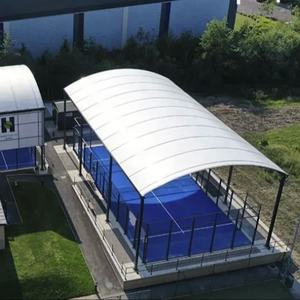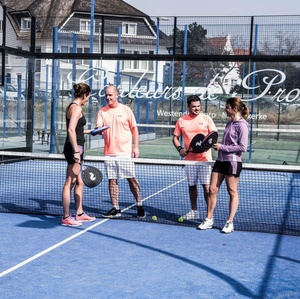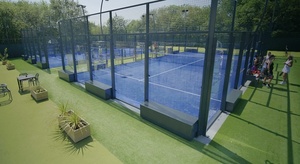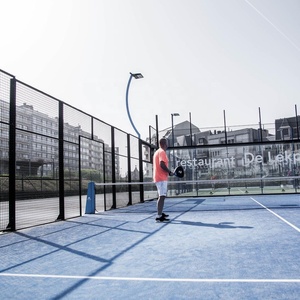(19227 products available)

































































































































































































































There are four main types of padel courts that are constructed. They include;
Glass Padel Court
Padel courts constructed with glass are quite popular around the world. The good thing about them is that they provide spectators with excellent views of the court's action from all angles. This setting makes it ideal for professional tournaments and clubs that want to offer their players a top-notch playing experience. Moreover, the glass used in these courts is tempered, which makes it more durable and able to withstand the impact of balls and changes in weather conditions.
Chain Link Padel Court
Another common type of padel court is the chain link court. The chain link courts are constructed using a fence made of chain-link materials. Just like the glass courts, they are durable and allow for great visibility for players and spectators. However, the chain-link material is less expensive compared to glass, which makes it a good option for clubs and schools working on a tight budget. In addition, the courts are low-maintenance and will not require frequent or costly maintenance.
Solid Wall Padel Court
A solid wall padel court is constructed with solid walls made of concrete, brick, or any other solid materials. The walls are able to withstand repeated strikes from the padel ball without any damage. This makes the solid wall courts very popular in areas with harsh weather conditions. Additionally, the walls of these courts have a consistent rebound effect, which provides a fair playing ground for all the players.
Mixed Material Padel Court
As the name suggests, mixed material padel courts are constructed with a combination of different materials. For instance, one can find a court made of glass and steel or any other combination of materials. This offers a unique playing experience and challenges the players' skills in different ways. Also, the mixed material courts are customizable, which allows the constructors to design a court that meets specific needs and requirements.
Padel courts are versatile facilities that cater to a range of activities and uses. Here are some of the key usage scenarios:
Competitive Padel Matches
Professional and amateur padel matches are held on courts. The courts provide the required playing conditions for players to showcase their skills, from local club competitions to professional championships.
Recreational Play
The primary purpose of padel courts is for people to enjoy. Friends, family, and colleagues can play on the courts and have fun, exercise, and socialize.
Training and Practice Sessions
The courts are used by players to improve their skills. Coaches conduct structured training sessions and drills on the courts to help players improve their technique, tactics, and fitness.
Padel courts are used by schools and sports academies to offer students and athletes opportunities to learn and play the game. The courts support the development of young talent and the promotion of padel as a sport.
Corporate Events and Team-Building Activities
Padel courts host company events and team-building activities. Employees participate in friendly matches and tournaments, which helps improve teamwork, communication, and camaraderie.
Charity Events and Fundraisers
Charity events and fundraisers are organized on padel courts. The events raise money for noble causes while providing an enjoyable platform for participants to donate.
Exhibitions and Demonstration Matches
Padel courts host exhibition and demonstration matches. The events feature professional players and celebrities, attracting spectators and promoting the sport.
Leagues and Club Competitions
Padel courts are used by sports clubs and facilities to hold league matches and club competitions. The events provide club members with competitive playing opportunities while fostering club spirit and camaraderie.
Fitness and Wellness Programs
Padel courts are included in fitness and wellness programs by gyms and wellness centers. The programs offer members a variety of physical activities that are fun and beneficial to their health.
When purchasing a padel court, there are several factors buyers should consider to ensure they meet the needs and requirements of the intended users. Here are some important factors.
Space Requirements
Before anything else, buyers should consider the space requirements. They should ensure there is enough space for the court including the playing area, fencing and surrounding areas. They can consult the installation manuals for dimensions and space requirements. They should consider the dimensions and space requirements to ensure the courts will fit in the intended area.
Surface Material
As discussed earlier, padel courts can be constructed using different surface materials. Each of these materials has its own advantages and disadvantages. Buyers should consider how each surface material will affect the game. For instance, artificial turf is popular since it offers good grip and drainage. Concrete on the other hand is durable but hard on the players' bodies. Acrylic surfaces are versatile but require regular maintenance.
Lighting
Buyers should consider the type of lighting they intend to install in the padel court. Proper lighting is crucial for both day and night games. Good lighting systems include LED lights and floodlights to ensure the court is well lit to avoid shadows and dark spots. If the players intend to use the court at night, proper lighting should be a priority.
Fencing and Walls
Most padel courts have walls for rebound and fencing for enclosure. Buyers should use durable materials that can withstand weather elements and regular impacts. They should also consider the height of the fencing and the walls to ensure they are within the required regulations.
Accessibility and Location
Finally, if the court is set to be in a public or shared location, buyers should ensure it is easily accessible to players of all skill levels. They should also consider the location of the court to ensure it is strategically located to attract players and encourage participation.
Surface Material
Padel courts are constructed using various surface materials that can be chosen based on durability, maintenance requirements, and playing characteristics. Common surface materials include artificial turf, concrete, asphalt, and gravel. The most prevalent surface is artificial turf, specifically designed for padel to provide optimal traction, drainage, and cushioning. It is typically infilled with silica sand to enhance stability and reduce wear. Artificial turf requires less maintenance than natural grass and offers a consistent playing surface in various weather conditions. Additionally, concrete and asphalt surfaces are used, providing a hard court experience similar to tennis. These surfaces are durable and require minimal maintenance but can be harsh on the players' bodies. The choice of surface material significantly impacts the game's speed, player movement, and overall comfort.
Lighting
Padel courts are equipped with lighting systems to enable play during evening hours and in low-light conditions. The lighting design ensures even distribution of light across the playing surface, minimizing shadows and glare. Typically, LED lights are used for their energy efficiency, longevity, and ability to provide bright, crisp illumination. The lighting levels on a padel court are set to meet specific standards, ensuring optimal visibility for players and spectators. The lighting poles are strategically placed around the court, often at a height of 4 to 6 meters, to achieve the required lux levels (brightness) without causing distractions or obstructions. The combination of well-designed lighting and appropriate surface material creates an ideal playing environment, allowing for competitive and enjoyable padel matches at any time of day.
Fencing
Padel courts are enclosed by fencing, which plays a crucial role in defining the playing area and maintaining the integrity of the game. The fencing is typically made of mesh panels, which are supported by metal posts. This design allows the ball to bounce off the walls in a controlled manner, facilitating the unique rallies and gameplay that padel is known for. The height of the fencing is standardized, usually reaching around 4 meters at the back and 3 meters at the sides, creating an enclosed space that is challenging for players while ensuring the ball remains in play. Additionally, the fencing helps to prevent outside interference, such as stray balls or spectators, from affecting the game. It also provides a degree of shelter from wind and other elements, making the padel court a more consistent playing environment.
Design
Walls
Padel courts feature walls as an integral part of the game, allowing the ball to be played off the wall in various shots and techniques. The walls are typically made of glass or solid materials, such as concrete or brick, providing a durable and consistent surface for the ball to bounce off. Glass walls are commonly used in professional-grade courts, offering spectators an unobstructed view of the game while providing players with a fair and predictable rebound. The height of the walls is standardized, typically reaching 4 meters at the back and 3 meters at the sides, creating an enclosed playing space that is both challenging and dynamic. The design and placement of the walls on a padel court add a unique element to the game, influencing shot selection, strategy, and overall gameplay.
Q1: What is the lifespan of a padel court?
A1: It varies depending on the materials used and how well the court is maintained. It can range from 20-35 years. The artificial grass surface may need replacement every 8-12 years.
Q2: Are padel courts environmentally friendly?
A2: It depends on the materials used and construction practices. Courts constructed with sustainable materials and have proper drainage systems can be considered environmentally friendly. There are also eco-friendly artificial grass options available.
Q3: Can a padel court be used year-round?
A3: Yes, it can be used year-round. However, users need to ensure that the court is properly maintained and cleared of snow or ice during winter.
Q4: What are the common accessories found in a padel court?
A4: Common accessories include nets, lighting systems, benches, scoreboards, and windbreaks.
Q5: How much space does a padel court need?
A5: A standard padel court needs an area of approximately 20 meters long and 10 meters wide, plus additional space around the court for safety and spectator areas.